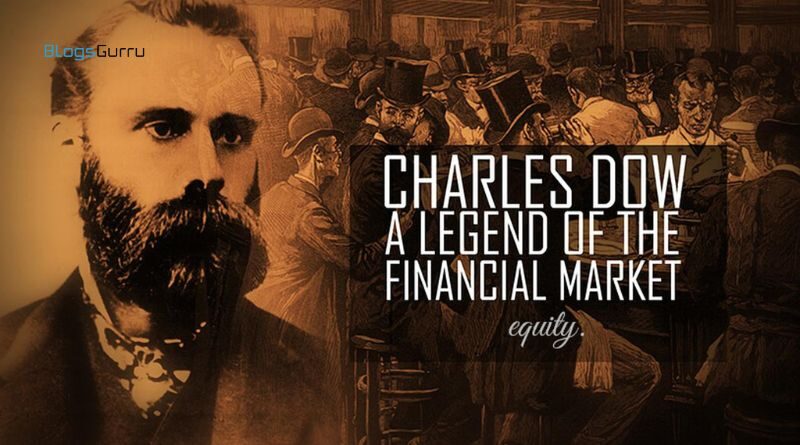Charles Dow
Charles Dow (November 6, 1851 – December 4, 1902) was a writer in the United States who co-founded Dow Jones & Company with Edward Jones and Charles Bergstresser. Charles Dow also co-founded The Wall Street Journal, which has grown to become one of the world’s most recognized financial magazines. As part of his studies on market movements, he also established the Dow Jones Industrial Average. He devised a set of concepts for understanding and interpreting market activity, which became known as Charles Dow’s theory and served as the foundation for technical analysis.
Who is Charles Dow and How he spent his Whole life?
Charles Henry Dow was born on November 6, 1851, in Sterling, Connecticut. His farming father died when he was six years old. The family resided in the hills of eastern Connecticut, close to the border with Rhode Island. Charles Dow had no schooling or expertise, but at the age of 21, he found employment with the Springfield Daily Republican in Massachusetts.
From 1872 until 1875, he worked as a city reporter for Samuel Bowles, who trained his reporters how to write concise, thorough pieces. Charles Dow subsequently relocated to Rhode Island, where he worked as a night editor for the Providence Star for two years. He also worked as a reporter for the Providence Evening Press. Dow joined the staff of the prestigious Providence Journal in 1877.
The editor, George W. Danielson, did not want to recruit the 26-year-old, but Charles Dow would not accept no for an answer. Danielson reconsidered after discovering Dow had worked for Bowles for three years and offered Dow a position writing business articles. Dow specialized in regional history essays, some of which were subsequently published as pamphlets. Dow’s work brought history to life by outlining the growth of numerous enterprises and their future potential.
He authored a History of Steam Navigation between New York and Providence in 1877. He released Newport: The City by the Sea three years later. It told the story of Newport, Rhode Island’s founding, development, fall, and rebirth as a summer vacation destination and home to a naval school, training station, and war college. Charles Dow published a study on Newport’s real estate investments, detailing the money gained and lost over the city’s history.
He also published histories of public education and the state jail system. Charles Dow’s meticulous study pleased Danielson so much that he sent him to join a party of bankers and reporters to Leadville, Colorado, to report on silver mining. The lenders want publicity in order to attract mining investors. Charles Dow and a group of tycoons, geologists, legislators, and investors set off on a four-day train excursion to Colorado in 1879.
Charles Dow learned a lot about the financial world as the guys smoked cigars, played cards, and traded tales. He spoke with several successful financiers and learned what kind of information Wall Street investors need to make money. The businesspeople seemed to enjoy and trust Charles Dow, knowing that he would correctly quote them and maintain their confidence. Dow based his “Leadville Letters” on his experiences there.
He depicted the Rocky Mountains, mining corporations, and the casinos, saloons, and dance halls of the boomtown. He also wrote about raw capitalism and the knowledge that propelled investments, instantly turning individuals into billionaires. He highlighted how individual mine owners and bankers who underwrote shares in multinational mining consortiums vanished.
cautioned in his final letter, “Mining securities are not suitable for widows and orphans, rural priests, or unworldly people in general. But there is no other investment in the market today that is as appealing to a businessman who must take risks in order to generate money; who will not purchase anything without rigorous, extensive examination; and who will not risk more than he is willing to lose.”
Also Read: S&P 500 nears first ‘golden cross’ in 2½ years, but this doesn’t guarantee more gains ahead
Charles Dow’s Personal Life
Charles Dow married Lucy, who had a daughter from a previous marriage, at the age of 30 after moving to New York City the previous year to accept a job opportunity. The couple did not have any children of their own. Dow and Jones first met in New York City.
Charles Dow working as an American journalist
Charles Dow moved from Providence to New York City in 1880, thinking that it was the optimum location for business and financial reporting. The 29-year-old got a job at the Kiernan Wall Street Financial News Bureau, which supplied handwritten financial news to banks and brokerages through messenger. Dow encouraged Edward Davis Jones to work alongside him when John J. Kiernan urged Dow to hire another reporter for the Bureau.
Jones and Charles Dow first met while working at the Providence Evening Press. Jones, a Brown University dropout, could examine a financial report swiftly and effectively. He, like Dow, was dedicated to reporting on Wall Street objectively. Other reporters might be persuaded to write favorable stories about a corporation in order to boost stock values. Dow and Jones declined to participate in stock market manipulation.
The two young guys thought Wall Street needed another financial news outlet. They established their own agency, Charles Dow, Jones & Company, in November 1882. The company’s headquarters were in the basement of a confectionery shop. Charles Bergstresser was the company’s principal funder, although he preferred to remain a silent partner. Bergstresser’s strongest suit was his ability to conduct effective interviews.
Jones once said he could make a wooden Indian speak and tell the truth. In November 1883, the corporation began publishing the Customers’ Afternoon Letter, a two-page afternoon summary of the day’s financial news. It quickly grew to over 1,000 subscribers and was regarded as a significant news source for investors. It contained the Dow Jones stock index, an index comprised of nine railroad companies, one steamship company, and Western Union.
In addition to his publishing activities, Charles Dow was a Partner in the NYSE trading company of Goodbody, Glynn, and Dow in 1885, where he stayed until its dissolution six years later. His partner, Robert Goodbody, was an Irish citizen and so ineligible to possess a seat at the time. Both guys will separate ways by 1891. Robert founded Robert Goodbody & Co, which grew to become the sixth-biggest brokerage business in the United States until being acquired by Merrill Lynch in 1971.
The publication of the Wall Street Journal
The firm had 50 workers in 1889. The partners concluded that the moment had come to turn their two-page news summary into a full-fledged newspaper. The Wall Street Journal published its inaugural edition on July 8, 1889. It costs two cents for every issue or $5 for a year’s subscription. Dow was the editor, while Jones was in charge of the office. The publication issued a policy statement to its readers: “Its goal is to provide complete and unbiased coverage of daily price swings in stocks, bonds, and some commodity classes.
It will strive to be a news publication rather than an opinion publication.” “The truth in its appropriate usage,” the paper’s motto read. Its editors claimed to provide a publication that was independent of advertisements. The publication had its own wire to Boston as well as telegraph lines to Washington, Philadelphia, and Chicago. It had reporters in a number of places, including London.
Dow often cautioned his reporters against swapping biassed articles for stock recommendations or free shares. Dow will disclose the names of corporations that refused to provide profit and loss statistics as part of its crusade for honesty in financial reporting. Soon after, the publication acquired strength and respect among its readers. Vermont Royster, a former editor of the Wall Street Journal, stated Dow always thought business knowledge was not the “exclusive domain of brokers and tycoons”.
The Wall Street Journal published its inaugural morning edition in 1898. The paper’s coverage has expanded beyond financial news. It also covered war, which, unlike many other journals, was reported objectively. Dow also introduced an editorial piece called “Review and Outlook,” as well as “Answers to Inquirers,” in which readers may submit investing queries to be addressed.
Although Edward Jones resigned in 1899, Dow and Bergstresser continued to work. Dow continued to write editorials, this time concentrating on the government’s role in American industry. During the 1900 election, The Wall Street Journal established a milestone in reporting by supporting a political candidate, incumbent President William McKinley.
Dow Jones Indices
Charles Dow developed the stock price average as part of the “Customer’s Afternoon Letter” on July 3, 1884. It began with 11 firms: 9 railroads and two non-rail enterprises, Pacific Mail Steamship and Western Union Telegraph. The “20 Active Stock” index was launched on September 23, 1889. It included 18 railroad equities and two non-rail stocks. Dow saw the end of the recession in the 1890s.
Many mergers started in 1893, leading to the establishment of massive businesses. These businesses sought markets for their equity shares. Because of the tremendously speculative nature of the market, investors need information on the stock activity. In 1896, Charles Dow used this chance to create the Dow Jones Industrial Average (DJIA). Dow calculated his average by following the closing stock prices of twelve businesses, adding up their values, and dividing by twelve.
On May26,1896, the Wall Street Journal published the first such average. The DJIA is still one of the world’s oldest and most popular stock indexes. Dow replaced the two non-rail firms in the “20 Active Stock” index with two rail stocks on October 25, 1896, and the index became the Dow Jones Railroad Average (DJRA). The Dow Jones Railroad Average (DJRA) remained a rail average of 20 companies until January 2,1970 when it was renamed to the Dow Jones Transportation Average (DJTA)—9 railroad firms were replaced with 9 airline and trucking stocks.
Stock price movement theory
Charles Dow began publishing an editorial section in his newspaper in 1899 in order to educate the common reader until his death in 1902. The column focused mostly on stock market activity and economic issues. In this column, he often expressed his beliefs on stock price swings, which ultimately became known as the Dow Theory. Unfortunately, the ordinary reader cannot access his whole editorial article. The majority of his works, however, may be found in the following books:
- Samuel Armstrong Nelson, The A B C of Stock Speculation”, 1902
- The Charles Dow Theory, by George W. Bishop and Charles H. Dow, was published in 1960.
- Dow Theory Unplugged: Charles Dow’s Original Editorials & Their Relevance Today, edited by Laura Sether, 2009
The core principle behind the Dow is that the stock price is influenced by several variables that interact at the same time, resulting in diverse patterns of stock price movement. The first step is to determine the link between these patterns and each relevant component using historical data. Following that, by analyzing the primary elements that are now in play, we can forecast the likely future movement of the stock price. His thesis on the three market movements was one of the most significant contributions to stock market philosophy.
How & when did Charles Dow Die?
Dow’s health started to deteriorate in1902, and Bergstresser wanted to retire. Clarence Barron, their Boston reporter, bought the two’s stock in the firm. Dow published his last editorial in April 1902. He died eight months later, on December4,1902, at the age of 51, at his house at 161 Lefferts Place in Brooklyn, New York, of a heart attack. Charles Dow is buried at Providence, Rhode Island’s North Burial Ground.




